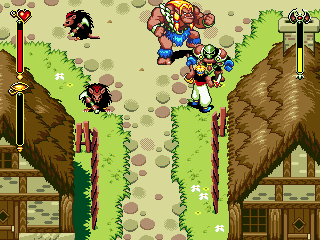In the second part of our Inspirations series, we sat down with Claudio, Cornfox Producer, and Level Designer. "My tasks range from managing partners relationships to designing the dungeons in the game. Cornfox is a small company, we all multitask."
Claudio grew up in Brazil, a country where high import duties never stopped the gaming scene in the 80s and 90s from resembling its US counterpart. Arcades, PC games, and consoles were popular, and kids spent their afternoons switching between NES, SNES, Megadrive, and MSX.
"Soon SEGA, Nintendo and other manufacturer started to build their consoles directly in Brazil. That way, duties weren't really an issue." Claudio spent the last 20 years developing games, moving from Brazil to Germany to Portugal. Six years ago he finally landed in Finland. "I met the Cornfox guys at various local game events. After a while, we realized we were aligned in tastes and philosophy, and that's how this adventure started."
When asked about the games that are influencing Oceanhorn 2's level design, Claudio goes back to the titles he grew up with. "The first Oceanhorn was a top-down game and shared the core gameplay with many Action RPGs of the 90s. We are now working on a third-person game: the camera can be controlled, there are 360 degrees of freedom, and there's verticality in the level design. That means, for example, that we can add floors to buildings and dungeons, or hidden areas that would be impossible to create using other kinds of perspectives."
Pacing is another area where Claudio focuses his efforts. "I want to have a balance between exploration and action, and make sure the learning curve is approachable, adding gameplay elements bit by bit." But what makes a game feel fresh even after several hours? When a new mechanic is added, balance feels right if the player is allowed to experiment with it. As soon as the new mechanic is learned, the game gets slightly harder or mixes it with elements that have already been introduced. This design philosophy can be applied to everything: combat, puzzle, exploration. "I love the Diablo games, but the mechanics there are mostly built around combat: in Oceanhorn 2 we need to make sure there's enough of everything, and that it comes in the right order, while also revealing the story bit by bit."
Good examples of what Claudio means can be found in two of the most popular game IPs: Zelda and Metroid. "In those games, skills and mechanics keep stacking. The level structure usually follows a plot-exploration-boss template, which works really well. We've been inspired by the best."
Oceanhorn 2: Knights of the Lost Realm is, in a sense, a "natural sequel" to the first Oceanhorn, as Ocarina of Time is a "natural sequel" to Link to the Past. "They are different games, of course, and Ocarina of Time deserves a special mention also because it changed how players interact with a 3D environment", says Claudio, "but in a way, both titles feel part of the same saga, and the pacing is what ties them together."
Claudio is also quick to add that there are other notable contributions to the Action RPGs space beside what Nintendo has been doing: less known titles such as Xak, Alundra, the Ys series, the Oasis series, Crusader of Centy, Terranigma, and others all have contributed to what Oceanhorn 2 is today. "When it comes to how the game looks", he concludes, "there's been a plethora of titles from the PS2 era that have informed Oceanhorn 2's style, but I think we owe something to Dawn of Mana, one of the sequels to Secret of Mana. That game looks still good today."
---
You can read pieces like this in advance subscribing to our newsletter!













No comments:
Post a Comment